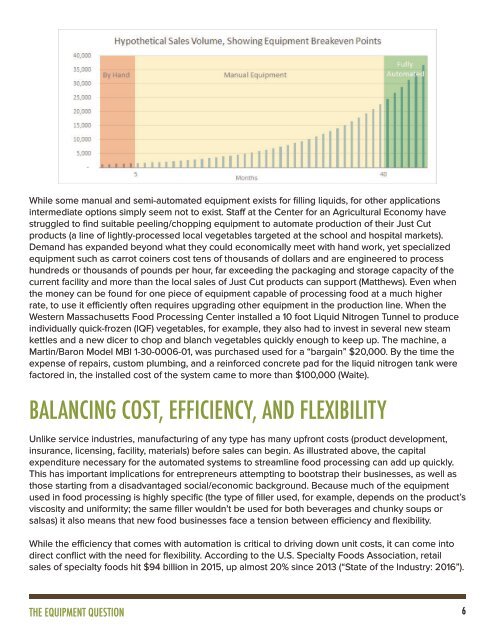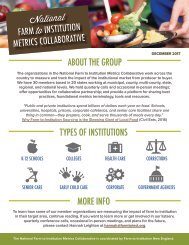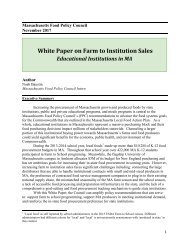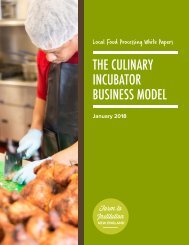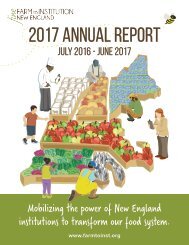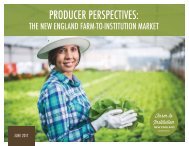FINE Equipment White Paper
You also want an ePaper? Increase the reach of your titles
YUMPU automatically turns print PDFs into web optimized ePapers that Google loves.
While some manual and semi-automated equipment exists for filling liquids, for other applications<br />
intermediate options simply seem not to exist. Staff at the Center for an Agricultural Economy have<br />
struggled to find suitable peeling/chopping equipment to automate production of their Just Cut<br />
products (a line of lightly-processed local vegetables targeted at the school and hospital markets).<br />
Demand has expanded beyond what they could economically meet with hand work, yet specialized<br />
equipment such as carrot coiners cost tens of thousands of dollars and are engineered to process<br />
hundreds or thousands of pounds per hour, far exceeding the packaging and storage capacity of the<br />
current facility and more than the local sales of Just Cut products can support (Matthews). Even when<br />
the money can be found for one piece of equipment capable of processing food at a much higher<br />
rate, to use it efficiently often requires upgrading other equipment in the production line. When the<br />
Western Massachusetts Food Processing Center installed a 10 foot Liquid Nitrogen Tunnel to produce<br />
individually quick-frozen (IQF) vegetables, for example, they also had to invest in several new steam<br />
kettles and a new dicer to chop and blanch vegetables quickly enough to keep up. The machine, a<br />
Martin/Baron Model MBI 1-30-0006-01, was purchased used for a “bargain” $20,000. By the time the<br />
expense of repairs, custom plumbing, and a reinforced concrete pad for the liquid nitrogen tank were<br />
factored in, the installed cost of the system came to more than $100,000 (Waite).<br />
BALANCING COST, EFFICIENCY, AND FLEXIBILITY<br />
Unlike service industries, manufacturing of any type has many upfront costs (product development,<br />
insurance, licensing, facility, materials) before sales can begin. As illustrated above, the capital<br />
expenditure necessary for the automated systems to streamline food processing can add up quickly.<br />
This has important implications for entrepreneurs attempting to bootstrap their businesses, as well as<br />
those starting from a disadvantaged social/economic background. Because much of the equipment<br />
used in food processing is highly specific (the type of filler used, for example, depends on the product’s<br />
viscosity and uniformity; the same filler wouldn’t be used for both beverages and chunky soups or<br />
salsas) it also means that new food businesses face a tension between efficiency and flexibility.<br />
While the efficiency that comes with automation is critical to driving down unit costs, it can come into<br />
direct conflict with the need for flexibility. According to the U.S. Specialty Foods Association, retail<br />
sales of specialty foods hit $94 billion in 2015, up almost 20% since 2013 (“State of the Industry: 2016”).<br />
THE EQUIPMENT QUESTION<br />
6


